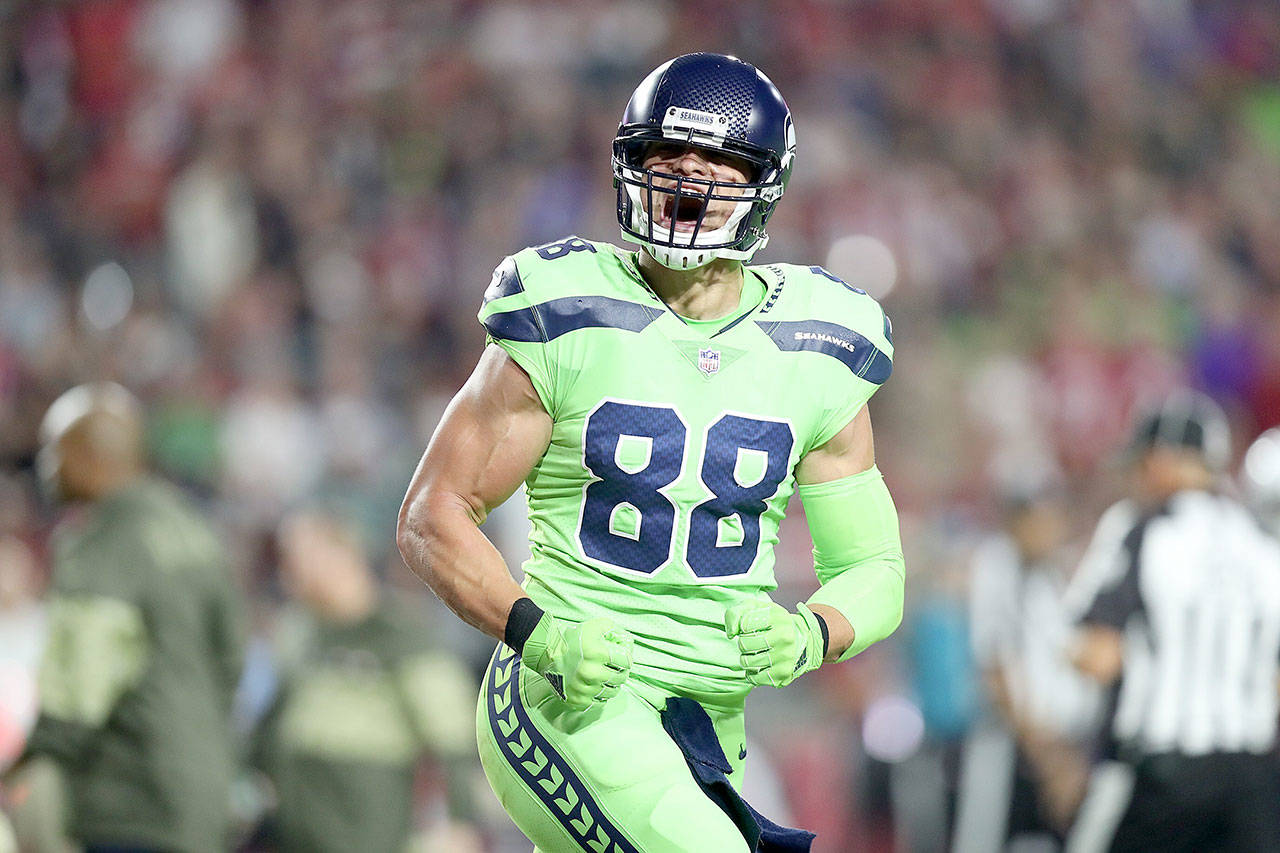By Bob Condotta
The Seattle Times
Maybe all Jimmy Graham needed was a vote of confidence.
Since the day the Seahawks declared emphatically that Graham wouldn’t be traded he has scored four touchdowns in three games — almost half as many as the 10 he had to that point in his first 33 games in Seattle.
Two came in the wild fourth quarterback comeback to beat Houston, which came a few hours after coach Pete Carroll and general manager John Schneider publicly denied a report that the team was considering trading Graham (a pledge fulfilled when the deadline passed two days later and he was indeed not dealt).
Two more came Thursday when he scored the only touchdowns for the Seahawks in a 22-16 win over Arizona. That gave him six touchdowns for the season, tying the number he scored last season and one off the Seattle record for receiving touchdowns by a tight end in a single season — John Carlson had seven in 2009.
Graham is also on pace for 69 receptions, which would break the team single-season record for a tight end he set last year of 65.
All of which led to a question to Doug Baldwin after the Arizona game about how big Graham has been of late.
“How big has he been?” Baldwin answered. “Well, he’s always been six-feet-12 and about 280 pounds. It’s huge. You know we’ve been harping on it, perfecting that pass in the red zone. It’s got to be easy for us. Russ (Russell Wilson) has got to make that throw. Jimmy has got to make that catch. That should be automatic for us.
“It’s been working out pretty well.”
That obviously hasn’t always been the case.
Seattle acquired Graham — actually listed at 6-foot-7, 265 — prior to the 2015 season in the wake of the ill-fated interception that that ended Super Bowl XLIX, hoping he’d provide the kind of big red zone target the team felt that play proved as fatal evidence was one of its biggest deficiencies.
But Graham caught just eight touchdowns his first two seasons (which were limited to 27 regular season games due to an injury in 2016) and none through the first four of this year, which began with Graham catching just four passes for nine yards.
Anyone thinking it might never work out for Graham in Seattle appeared to have the last bit of evidence they needed when he had two costly drops in the first half of an Oct. 22 game against the Giants in New York, each of possible touchdowns, and one on a fourth-and-goal play at the 1 — exactly the kind of situation that was the reason the team got him.
At halftime of that game — 22 quarters into the season — Graham had 22 receptions for 200 yards and one touchdown.
Graham came back to catch two passes in the second half of that game, one for a touchdown. In those 14 quarters since, he has 17 receptions for 165 yards and five touchdowns.
What’s changed?
Everyone involved insists nothing, really, other than sticking with it.
Aside from the 18-yard TD that won the Houston game with 21 seconds left, Graham’s other touchdowns this season have all come from the 6-yard-line or closer, Seattle appearing to make even more of an effort than in the past at going to him when inside the 10 (that the running game is lacking makes it even more enticing to go to Graham and more critical that Seattle makes those plays work).
“He threw it up and gave him a chance to get up for it and then there was beautiful execution down there on the goal line,” Carroll said of Graham’s touchdowns of six and two yards against Arizona. “I know everyone’s been waiting to see that and we’re seeing that.”
Pro Football Focus’ breakdown of Graham’s usage before the Giants game (which came after Seattle’s bye) and after don’t show any real major changes.
The biggest is that Graham has lined up in the slot more — 38 percent since the bye, 32 percent before it — though that hardly seems overly significant.
What has changed is Graham’s production. Wilson had a 59.1 passer rating when throwing to Graham before the bye with one touchdown and two interceptions. He has a 121.4 rating since then, with five touchdowns and no interceptions when targeting Graham.
“He’s arguably one of the best tight ends to ever play the game,” Wilson said Thursday night. “He has played spectacularly and doing what we know he can do and we just give him chances and we are finding our way. We’re working at it.”
Graham’s future remains unclear — he turns 31 on Nov. 24 and can become an unrestricted free agent at the end of the season with no indications so far the two sides have talked about an extension (though suddenly, the idea that he’d need to get out of Seattle to get to an offense that would be a better fit for his skills may not be as true as it used to be with the Seahawks throwing it 60.1 percent of the time this season, their highest percentage since 2010 and 11th in the NFL entering the weekend, according to teamrankings.com).
But the team’s declaration that it wasn’t trading Graham was more about the present — Seattle’s in win-now mode and Schneider has said Graham is the kind of gamebreaker not easily found.
“He’s just that kind of player,” Carroll said after the Arizona game. “You can really, you can know it’s coming (as a defense) and you (Graham) can get it anyway.”
It’s always sounded just that easy. The Seahawks hope they can keep making it look that easy, too.


